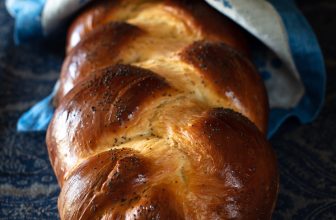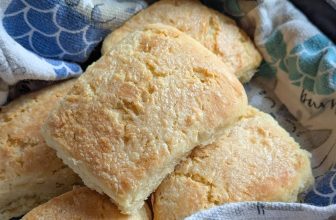
I’ve always thought fougasse, sometimes called the French cousin of focaccia, was quite beautiful, and I could see it had a lot of golden-tasty crust surface area, but it wasn’t until I tried it that I understood the fuss—why you would flatten and cut up your dough! Now I’m a bit obsessed and will probably be fougasse-ing all sorts of dough in the future for my crispy-crust-for-miles enjoyment. Cranberry walnut? Jalapeño cheddar? The heirloom red fife fougasse from the Breadtopia archives? Yes, yes and yes.
This precise olive-rosemary-oregano sourdough fougasse recipe though? It will be on repeat in my house. As soon as I took a bite, I was tempted to finish an entire fougasse and pretend to my family that I’d only baked one and not two. (I did managed to stop at half a fougasse, which is equivalent to about 1/4 a loaf of bread.) The family also found the fougasse irresistible, making comments around mouthfuls like, “Make this again,” and “One of the best breads you’ve made.”
The use of rouge de bordeaux whole grain flour in the dough adds complex spice-flavor, but you can make flour substitutions as needed, just add water slowly. The recipe was inspired by a yeast-leavened fougasse with kalamata olives, herbs, and chilis on the blog Add1Tbsp. I used green olives that were originally stuffed with garlic and jalapeños, but when I quartered them, I removed (ate) the filling so only olives were included in the dough. Nonetheless, some heat came through in the bread and that was enjoyable, so if I make this with unstuffed olives, I may add a tablespoon of minced pickled jalapeños, or a couple of Calabrian chilis as per the original recipe.
Here is a video (no sound) showing one way to add olives and herbs to dough. The dough in the video is this Olive and Walnut Sourdough Spelt Bread. You can also simply mix in the additions after a brief rest of the dough, which is what I did with my fougasse dough.
This video shows how to divide, pre-shape, shape and cut fougasse dough. You can follow the pattern of cuts depicted in the video or make your own design.
Olive and Herb Sourdough Fougasse
The combination of flavors and textures in this olive and herb fougasse is simply exceptional. The golden crust is crispy from olive oil and caramelized from the hot bake, and the green olives, rosemary, oregano, black pepper and aromatic rouge de bordeaux wheat work together to create a bread you won’t want to stop eating.
Total Time
1 hour, 5 minutes
Ingredients
- 250 grams bread flour (2 cups)
- 250 grams rouge de bordeaux whole grain flour (2 cups)
- 340 grams water (1 1/3 cup + 1.5 Tbsp)
- 100 grams sourdough starter (1/3 cup)
- 25 grams olive oil (2 Tbsp)
- 11 grams salt (2 tsp)
- 105 grams olives, pitted and quartered (1 cup)
- optional 1 Tbsp minced pickled jalapeños
- 1 Tbsp dried oregano, not packed down
- 1 Tbsp dried rosemary, not packed down
- additional salt and black pepper to sprinkle on the dough just before baking
Instructions
- The bread can be an all-day, room-temperature process, or you can refrigerate the dough during the bulk fermentation to resume the process the next day. My dough expanded by about 70% in 5 hours at room temp, then I refrigerated it overnight. In the morning, I set it on the counter to finish rising for a couple of hours, to about 80% expansion. Dividing, pre-shaping and the bench rest took 20-30 minutes. The final proof was 1 hour. I cut and topped the fougasse, and they baked for 20 minutes. This adds up to about 5 hours on the second day.
- Mix the flours, water, sourdough starter, olive oil and salt together in a large bowl. Cover and let the dough rest for 20-30 minutes.
- Add the olives and herbs to the dough, stretching and folding until these additions are incorporated in the dough. This can also be done via lamination or stand mixing. If you want to do a round or two of coil folding or stretching and folding over the next hour, that is also an option.
- Transfer the dough to a straight-walled container and let it rise to about 80% expansion. This could take 5-10 hours, depending on the dough temperature, or you could extend the process and refrigerate the dough as I did toward the end of the expansion.
- On a lightly floured work surface, divide the dough in two. Preshape into two balls and let the dough rest about 20 minutes. Uncovered is fine.
- Line two baking sheets with parchment paper and grease the paper with olive oil.
- Place one of the dough balls on the parchment paper, flattening and stretching it out into a long triangle shape with your hands and a rolling pin. Repeat with the second dough.
- Cover the dough with oiled plastic wrap or place the baking sheets in tented bags.
- Let the dough proof 1-2 hours, until it is puffier.
- Set up your oven racks so you can load both baking sheets if possible and begin preheating your oven to 450F before the final proof is complete.
- Using a pizza wheel or knife, make cuts in the dough. See this video for more instructions. Repeat with the second dough.
- Spray or brush olive oil onto the doughs and sprinkle with salt and pepper. If you’re watching your sodium intake, skip the salt in this step as the olives already add salt.
- Load the trays into the preheated oven.
- Bake for 20 minutes. About halfway through, switch the bottom and top baking sheets and turn them as needed for even browning.
- When the fougasses are done baking, brush them again with olive oil.
- Serve warm and crispy if possible. Leftovers can be stored in a bag or beeswax wrap to prevent staling and toasted to re-crisp.







![Homemade Sourdough Breadcrumbs [One Ingredient]](https://som2nynetwork.com/wp-content/plugins/phastpress/phast.php/c2VydmljZT1pbWFnZXMmc3JjPWh0dHBzJTNBJTJGJTJGc29tMm55bmV0d29yay5jb20lMkZ3cC1jb250ZW50JTJGdXBsb2FkcyUyRjIwMjUlMkYxMSUyRnNwb29uLW9mLXNvdXJkb3VnaC1icmVhZGNydW1icy0zMzZ4MjIwLmpwZyZjYWNoZU1hcmtlcj0xNzYzOTYyOTAwLTIxOTUyJnRva2VuPTRlYTJiYTZiZDY1OThmOTk.q.jpg)


